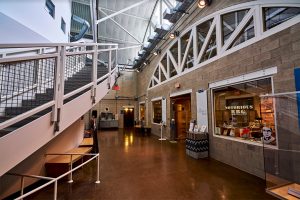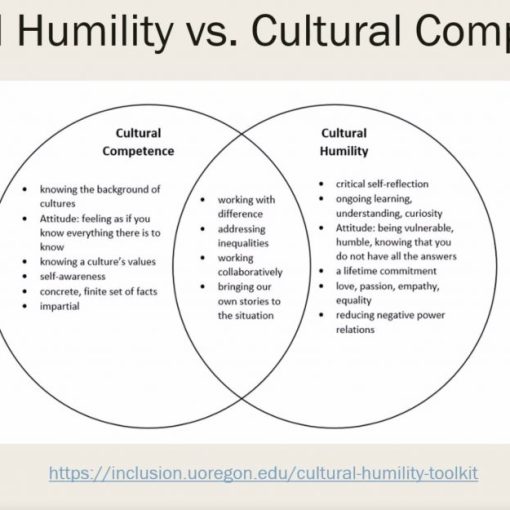The Hyperlinked Museum: Technology as a Tool of Remembrance
Reflection Blogging: Week 6 – Hyperlinked Environments & Issues

I would like to direct my reader to a particularly fascinating example of technology implementation in museum spaces that I encountered last semester while working on a Strategic Plan to modernize Angel Island Immigration Station in San Francisco Bay for INFO 204. As a diasporic museum, to help revolutionize AIIS my group was concerned with how other cultural institutions have approached technology to catalyze interest amongst its patrons; in our findings, we came across the Illinois Holocaust Museum & Education Center, which started using interactive AI hologram technology to host simulated interviews with Holocaust survivors. “The survivor has been recorded answering thousands of questions,” reports the Chicago Tribune in the video below exploring how students engage with the exhibit, creating a riveting and extremely personal environment that is “just about as lifelike as it could possibly be” (Illinois Holocaust Museum & Educational Center, 2018).
We referenced this particular patron experience in our findings and suggestions for AIIS because visitors remark on just how profound it is, especially for the Jewish community in Chicago during “a disturbing rise in anti-Semitism” in the U.S. in recent years (NBC News, 2023). I highly recommend viewing the news report linked below to get a better sense of the statistical breadth of the impact the Illinois Holocaust Museum has had with this incalculably valuable project, as it offers some insight from the survivors they have preserved in this exhibit. I warn the reader now that it handles extremely heavy topics of genocide, loss, and grief; view with caution.
I present the Illinois Holocaust Museum as a case study for how hyperlinked environments transcend the physical limitations of their collections. In fraught, dangerous political climates, efforts on behalf of museums such as this connect young people across increasingly distant temporal boundaries, helping not only to preserve but to enliven these stories that, not too long from now, we will no longer be able to experience firsthand. I especially appreciated how Manuel Charr framed this technological reinvigoration of museum spaces in his article, “How technology is bringing museums back to life.” He says,
Technology shouldn’t be seen as the enemy of culture. On the contrary, when used well, technology can help bring visitors closer than ever to a museum, and the history a museum is trying to convey.
Like any tool, technology is only as effective as its implementation… by using technology smartly, museums can increase focus and interest on their collections (2020).
The prevalent theme in many of the readings concerning museums and galleries from this module is reflected nicely in the above quotation; that these kinds of innovative tools are a boon for vitalizing museum spaces into actively educational environments, and their use shouldn’t be regarded with fear or reservations – one need not look any further than Chicago to see what a well-configured experience can do to connect us not just as students but as people to an increasingly distant but eternally relevant history. So effectively has it bridged those gaps, in fact, that visitors “forget that it’s a system, they are talking to a human being, they are asking someone questions” (Sumanac-Johnson, 2019), and, in doing so, getting answers.
References
Charr, M. (2020, June 17). How technology is bringing museums back to life. MuseumNext. https://www.museumnext.com/article/how-technology-is-bringing-museums-back-to-life/
Illinois Holocaust Museum & Education Center. (n.d.) Interactive holograms: Survivor stories experience. https://www.ilholocaustmuseum.org/exhibitions/survivor-stories-experience/
Illinois Holocaust Museum & Education Center. (2018, February 21). Meet virtual Holocaust Survivors [YouTube Video]. https://www.youtube.com/watch?v=uG4Z5TbMrFs&t=197s
Knight Foundation. (2017, May 18). 12 art museums to engage audiences with new technologies with $1.87 million from Knight Foundation [Press Release]. Knight Foundation. https://knightfoundation.org/press/releases/12-art-museums-to-engage-audiences-with-new-technologies-with-1-87-million-from-knight-foundation/
NBC News. (2023, January 26). Illinois Holocaust Museum preserves survivors’ stories through virtual reality {YouTube Video]. https://www.youtube.com/watch?v=ycSKsvVj6So
Sumanac-Johnson, D. (2019, November 10). Holocaust holograms: how survivors’ stories live on through new technology. CBC News.



5 thoughts on “The Hyperlinked Museum: Technology as a Tool of Remembrance | Reflection Blogging: Week 6 – Hyperlinked Environments & Issues”
@gilbertmaryjoy Thank you so much for sharing this powerful use of technology to preserve history and to combat antisemitism. You could tell by how engaged and attentive the kids were in their question and answer session with the hologram of the holocaust survivor. The Illinois Holocaust Museum is indeed a hyperlinked environment as it transcends time to bring history alive for a younger generation. Thanks again for sharing this!
Yes! That was what drew me to that video initially is how engaged the children are in the audience. I work with children every day and I can tell when students are enjoying a book we’re reading based on how zoned in they are to the conversation and how much they want to discuss what we read afterwards. It’s such a fantastic museum that I desperately want to visit if I can someday.
@gilbertmaryjoy thank you for this essay on galleries and museums. It’s one of the most interesting spaces to me right now where change is happening. I appreciate the examples you shared — they resonate. The exhibits and interactive experiences you highlight are important for people to see and understand. I hope we see more and more of this going forward. More stories shared more lives changed.
oops…got as little poetic there.
This is a great article @gilbertmaryjoy I really enjoy the possibilities digital archiving brings to light! I used to think chatbots were really cool as a kid since it was like someone to talk to, but from a completely different mindset since it’s a program. Obviously libraries would use this more practically to teach people based on knowledge that has been gathered, but it can be implemented in games to help teach people lessons on security, early life skills, or on the field work experience! I know museums can really benefit as they won’t have a bunch of strangers that might knock over their priceless artifact.